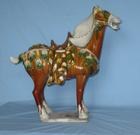Tang Dynasty
General Introduction to Tang Dynasty
 Tang Dynasty was an imperial dynasty of China preceded by the Sui Dynasty and followed by the Five Dynasties and Ten Kingdoms Period. It was founded by the Li family, who seized power during the decline and collapse of the Sui Empire. The dynasty was interrupted briefly by the Second Zhou Dynasty (October 16, 690–March 3, 705) when Empress Wu Zetian seized the throne, becoming the first and only Chinese empress regnant, ruling in her own right.
Tang Dynasty was an imperial dynasty of China preceded by the Sui Dynasty and followed by the Five Dynasties and Ten Kingdoms Period. It was founded by the Li family, who seized power during the decline and collapse of the Sui Empire. The dynasty was interrupted briefly by the Second Zhou Dynasty (October 16, 690–March 3, 705) when Empress Wu Zetian seized the throne, becoming the first and only Chinese empress regnant, ruling in her own right.
Viewing the Chinese history record, you will find the Tang Dynasty was the most glistening historic period in China's history. Founded in 618 and ending in 907, the state, under the ruling of the Tang Dynasty, became the most powerful and prosperous country in the world. Particularly, in this glorious period, the economy, politics, culture and military strength reached an unparalleled advanced level.
Establishment
At the end of Sui Dynasty (581 - 618), the whole country fell into chaos due to the tyranny of Emperor Yang; rebellions roused by peasants were everywhere. Resenting Emperor Yang's ruling, the chief officer of Taiyuan - Li Yuan, who was also known as Tangguo Gong (a vassal in Sui Court) raised an army in Taiyuan from May 617. In November of the same year, Li Yuan's army captured the capital city Chang'an (currently Xian) and put a new monarch, Yang You, on the throne as Emperor Gong. Meanwhile, Li Yuan proclaimed himself Da Chengxiang (prime minister) and Tang Wang (King of Tang). In 618 after Emperor Yang was killed by his chancellor, Yuwen Huaji, Li Yuan seized the chance to proclaim himself emperor and changed the state title into Tang, still with Chang'an as the capital city.
Administration and politics
Taizong set out to solve internal problems within the government which had constantly plagued past dynasties. Building upon the Sui legal code, he issued a new legal code that subsequent Chinese dynasties would model theirs upon, as well as neighboring polities in Vietnam, Korea, and Japan. The earliest law code to survive though was the one established in the year 653, which was divided into 500 articles specifying different crimes and penalties ranging from ten blows with a light stick, one hundred blows with a heavy rod, exile, penal servitude, or execution. The legal code clearly distinguished different levels of severity in meted punishments when different members of the social and political hierarchy committed the same crime. For example, the severity of punishment was different when a servant or nephew killed a master or an uncle than when a master or uncle killed a servant or nephew. The Tang Code was largely retained by later codes such as the early Ming Dynasty (1368–1644) code of 1397, yet there were several revisions in later times, such as improved property rights for women during the Song Dynasty (960-1279).
Military and foreign policy
The 7th century and first half of the 8th century is generally considered the zenith era of the Tang Dynasty. Emperor Tang Xuanzong brought the Middle Kingdom to its golden age while the Silk Road thrived, with sway over Indochina in the south, and to the west Tang China was master of the Pamirs (modern-day Tajikistan) and protector of Kashmir bordering Persia. Some of the kingdoms paying tribute to the Tang Dynasty included Kashmir, Nepal, Khotan, Kucha, Kashgar, Japan, Korea, Champa, and kingdoms located in Amu Darya and Syr Darya valley. Turkic nomads addressed the Emperor of Tang China as Tian Kehan. After the widespread Göktürk revolt of Shabolüe Khan (d. 658) was put down at Issyk Kul in 657 by Su Dingfang (591-667), Emperor Gaozong established several protectorates governed by a Protectorate General or Grand Protectorate General, which extended the Chinese sphere of influence as far as Herat in Western Afghanistan. Protectorate Generals were given a great deal of autonomy to handle local crises without waiting for central admission. After Xuanzong's reign, military governors (jiedushi) were given enormous power, including the ability to maintain their own armies, collect taxes, and pass their titles on hereditarily. This is commonly recognized as the beginning of the fall of Tang's central government
Trade and spread of culture
Through use of the land trade along the Silk Road and maritime trade by sail at sea, the Tang were able to gain many new technologies, cultural practices, rare luxury, and contemporary items. From the Middle East, India, Persia, and Central Asia the Tang were able to acquire new ideas in fashion, new types of ceramics, and improved silver-smithing. The Chinese also gradually adopted the foreign concept of stools and chairs as seating, whereas the Chinese beforehand always sat on mats placed on the floor.[92] To the Middle East, the Islamic world coveted and purchased in bulk Chinese goods such as silks, lacquerwares, and porcelain wares. Songs, dances, and musical instruments from foreign regions became popular in China during the Tang Dynasty. These musical instruments included oboes, flutes, and small lacquered drums from Kucha in the Tarim Basin, and percussion instruments from India such as cymbals. At the court there were nine musical ensembles (expanded from seven in the Sui Dynasty) representing music from throughout Asia
Society and culture
Both the Sui and Tang Dynasties had turned away from the more feudal culture of the preceding Northern Dynasties, in favor of staunch civil Confucianism. The governmental system was supported by a large class of Confucian intellectuals selected through either civil service examinations or recommendations. In the Tang period, Daoism and Buddhism reigned as core ideologies as well, and played a large role in people's daily lives. The Tang Chinese enjoyed feasting, drinking, holidays, sports, and all sorts of entertainment, while Chinese literature blossomed and was more widely accessible with new printing methods.
Decline of Tang Dynasty
In his old age, Emperor Xuanzong was complacent and indifferent to state affairs. Hopelessly, he indulged himself in the beauty of his concubine Yang Yuhuan. Besides, he also appointed some wicked chancellors who corrupted the political order. Meanwhile, troops on the frontiers gradually gathered together and formed a powerful military force. In 755, An Lushan aligned with Shi Siming and launched a rebellion, called the An Shi Rebellion which lasted for eight years and heavily knocked the Tang regime. From then on, the national strength was weakened daily by separatist forces in local areas.
Because of the incompetence of the emperors the dominance of the eunuchs and power struggles between chancellors became increasingly intense. Hence the Tang Dynasty declined from generation to generation. In 859, a large-scale peasant uprising launched by Huang Chao again severely attacked the Tang regime. In 907, the last Tang emperor, Emperor Ai was forced to abdicate by Chancellor Zhu Quanzhong, who afterwards changed the state title into Liang, finally putting the ever powerful and mighty Tang Dynasty to an end.



 闽公网安备 35020302000788号
闽公网安备 35020302000788号